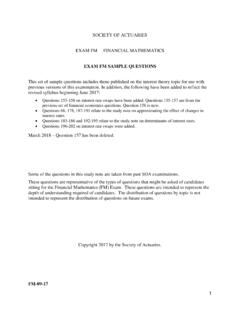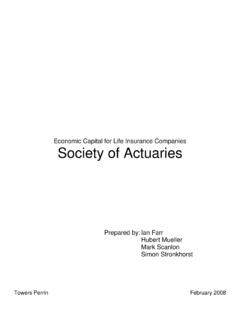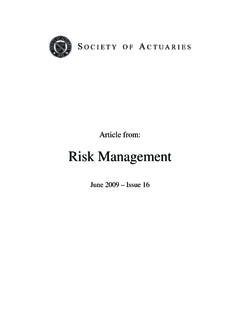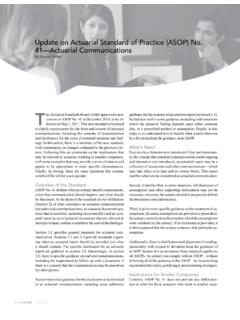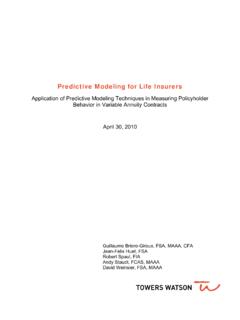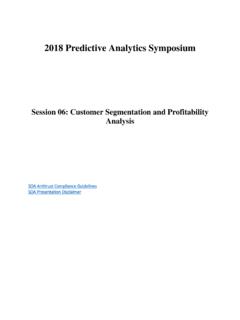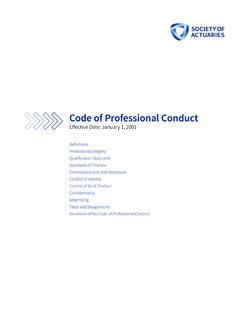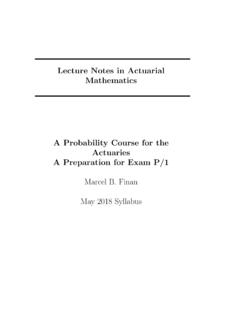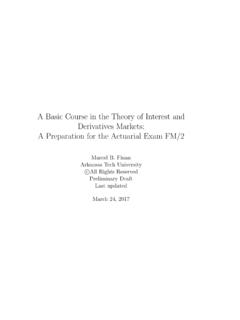Transcription of EXAM FM SAMPLE SOLUTIONS - Member | SOA
1 1 SOCIETY OF ACTUARIES exam fm FINANCIAL MATHEMATICS exam fm SAMPLE SOLUTIONS This set of SAMPLE questions includes those published on the interest theory topic for use with previous versions of this examination. In addition, the following have been added to reflect the revised syllabus beginning June 2017: Questions 155-158 on interest rate swaps have been added. Questions 155-157 are from the previous set of financial economics questions. Question 158 is new. Questions 66, 178, 187-191 relate to the study note on approximating the effect of changes in interest rates. Questions 185-186 and 192-195 relate to the study note on determinants of interest rates.
2 Questions 196-202 on interest rate swaps were added. March 2018 Question 157 has been deleted. Some of the questions in this study note are taken from past SOA examinations. These questions are representative of the types of questions that might be asked of candidates sitting for the Financial Mathematics (FM) Exam. These questions are intended to represent the depth of understanding required of candidates. The distribution of questions by topic is not intended to represent the distribution of questions on future exams . The following model SOLUTIONS are presented for educational purposes. Alternative methods of solution are, of course, acceptable.
3 In these SOLUTIONS , ms is the m-year spot rate and mtf is the m-year forward rate, deferred t years. Copyright 2017 by the Society of Actuaries. FM-10-17 2 1. Solution: C Given the same principal invested for the same period of time yields the same accumulated value, the two measures of interest (2) and must be equivalent, which means: 2(2)12ie += over a one-year period. Thus, 2(2) ( ) =+== == 2. Solution: E From basic principles, the accumulated values after 20 and 40 years are 424201644444403644(1)(1)100[(1)(1)(1) ] 1001 (1)(1)(1)100[(1)(1)(1) ] (1)iiiiiiiiiiii+ ++ ++ + ++ = ++ ++ ++ + ++ = + The ratio is 5, and thus (setting 4(1)xi= +) 44411424661151010555(1)(1)5(1)(1)5555 15 40(1)(4) x xxxxxxxx+ + ==+ + = = += = Only the second root gives a positive solution.
4 Thus == 3 Annuity symbols can also be used. Using the annual interest rate, the equation is 40204440204020201005(100)(1)1(1)15(1)5(1 )40(1)4ssaaiiiiiii=+ + =+ ++=+= and the solution proceeds as above. 3. Solution: C Eric s (compound) interest in the last 6 months of the 8th year is 15100 122ii + . Mike s (simple) interest for the same period is 2002i. Thus, 1515100 += += +=== 4. Solution: A The periodic interest is (10,000) = 1000. Thus, deposits into the sinking fund are = Then, the amount in sinking fund at end of 10 years is 10 ,133s=. After repaying the loan, the fund has 2,133, which rounds to 2,130.
5 4 5. Solution: E The beginning balance combined with deposits and withdrawals is 75 + 12(10) 5 25 80 35 = 50. The ending balance of 60 implies 10 in interest was earned. The denominator is the average fund exposed to earning interest. One way to calculate it is to weight each deposit or withdrawal by the remaining time: 11 1001065275(1) 121212122412 + + ++ = The rate of return is 10 = = 6. Solution: C ( ) ( ) ( )nnnnnnnnnnnnnnvv Iaianvnvviianvnvii iavviivn++++ =+ =+ = + = === == = To obtain the present value without remembering the formula for an increasing annuity, consider the payments as a perpetuity of 1 starting at time 2, a perpetuity of 1 starting at time 3, up to a perpetuity of 1 starting at time n + 1.
6 The present value one period before the start of each perpetuity is 1/i. The total present value is 2(1 / ) ()(1 / ).nni v vvia+++ = 5 7. Solution: C The interest earned is a decreasing annuity of 6, , etc. Combined with the annual deposits of 100, the accumulated value in fund Y is ( )()10 ()10010 + =+ =+= 8. Deleted 9. Solution: D For the first 10 years, each payment equals 150% of interest due. The lender charges 10%, therefore 5% of the principal outstanding will be used to reduce the principal. At the end of 10 years, the amount outstanding is ()101000 1 =. Thus, the equation of value for the last 10 years using a comparison date of the end of year 10 is 10 10% 10.
7 Solution: B The book value at time 6 is the present value of future payments: 464 , 10, + =+= The interest portion is 10,693( ) = 11. Solution: A The value of the perpetuity after the fifth payment is 100 = 1250. The equation to solve is: 224251250( )()(25) / ( ) vv XX= + ++= ++ + === 6 12. Solution: C Equation of value at end of 30 years: 4040304030401/ 4010(1/ 4)( )20( )10010(1/ 4)[100 20( ) ] / 4 (1 ) += = = === == 13. Solution: E The accumulation function is 230( ) exp(/ 100)exp( / 300).ta tsdst == The accumulated value of 100 at time 3 is 3100 exp(3 / 300) The amount of interest earned from time 3 to time 6 equals the accumulated value at time 6 minus the accumulated value at time 3.
8 Thus () [ (6) / (3) 1]( )( / 1)( ) aXXXXXXX+ =+ =+=== 14. Solution: A 55 (1) 1010( ) (1) / (1) / ( )[1 (1) / ] (1) / (1) / =+ =+ +=+ + +=+=++== = 99%. 7 15. Solution: B 10 1: 2000299 Total payments2990 Option 2: Interest needs to be 2990 2000 990990[2000 1800 1600200]11, = == ++++== = 16. Solution: B Monthly payment at time t is 11000( )t . Because the loan amount is unknown, the outstanding balance must be calculated prospectively. The value at time 40 months is the present value of payments from time 41 to time 60: 40 159204040 160211000[ ] ,1 / ( )1 ++ == == 17.
9 Solution: C The equation of value is ( )323298988000(1)1(1) +=+ + +=+= +=== 8 18. Solution: B Convert 9% convertible quarterly to an effective rate of j per month: (1)14j +=+ or j = Then 6060 ( ) === 19. Solution: C For Account K, the amount of interest earned is 125 100 2X + X = 25 X. The average amount exposed to earning interest is 100 (1/2)X + (1/4)2X = 100. Then 25100Xi =. For Account L, examine only intervals separated by deposits or withdrawals. Determine the interest for the year by multiplying the ratios of ending balance to beginning balance. Then 125 125iX= Setting the two equations equal to each other and solving for X, 222513, 2251100100(125)(25)(125) 13, 225 100(125)3,125 15013, 225 12, 500 1002502, 400 = = += + +== Then i = (25 10)/100 = = 15%.
10 9 20. Solution: A Equating present values: 2102101010100 200300600100 200( ) 300( ) vvvvvii++ =++ ===== +== 21. Solution: A The accumulation function is: ( )001ln 888().8ttdrrrtatee+++ === Using the equation of value at end of 10 years: ()10101000 0(10)18 / 820, 0008(8)18( )(8) / 820, tkdtktdtkdtattkk=+=+ =+= == 22. Solution: D Let C be the redemption value and 1 / (1)vi= +. Then ( )(1 ) + =+= += 23. Solution: D Equate net present values: 224000 200040002000 XvXX ++ =+ +=+= 10 24. Solution: E For the amortization method, the payment is determined by 20 , , For the sinking fund method, interest is (20,000) = 1600 and total payment is given as X, the same as for the amortization method.
